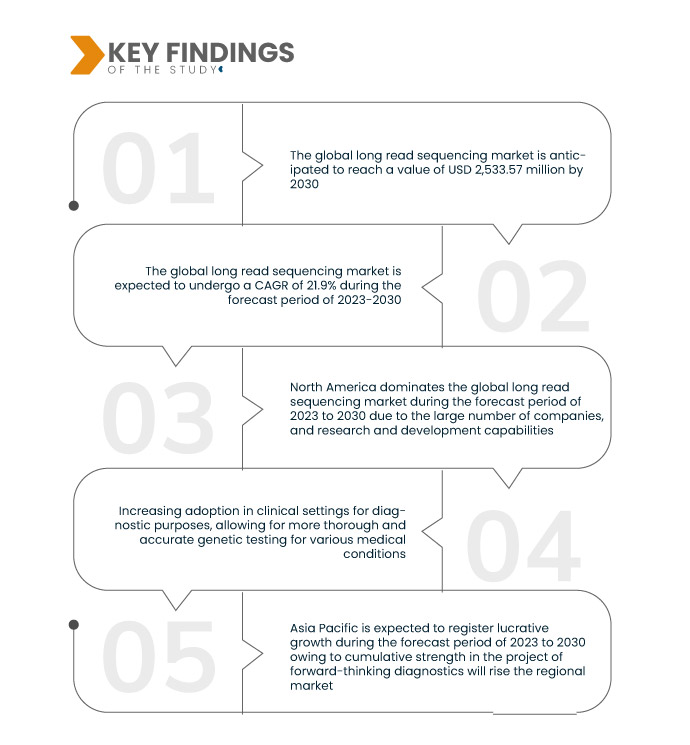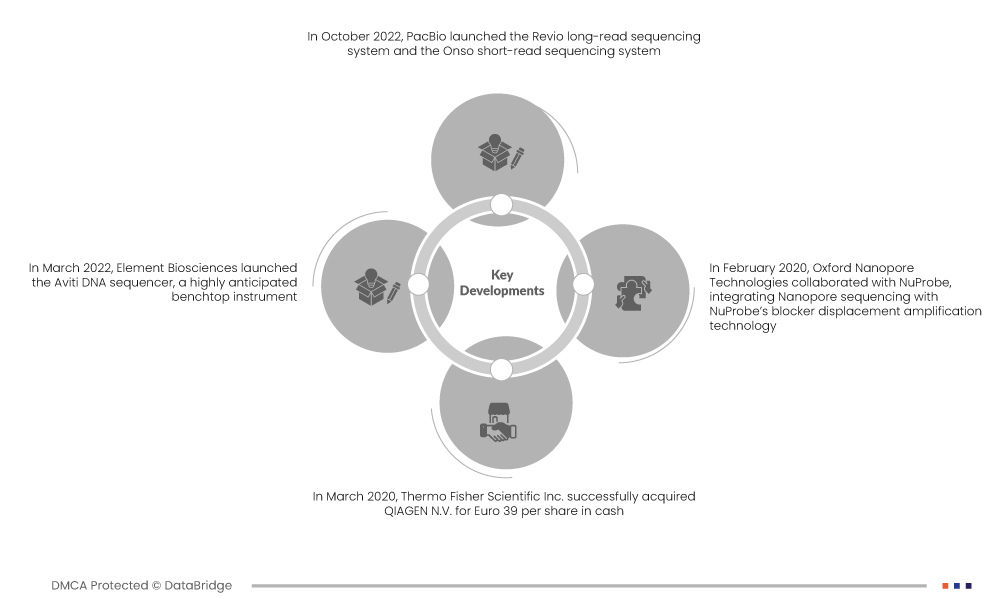Глобальный рынок длинных прочтений использует передовые технологии для высокоточного и обширного декодирования ДНК. Длинные прочтений секвенирования, преобразующий подход геномики, преодолевает ограничения коротких прочтений секвенирования. Он анализирует большие генетические отрезки, распутывая сложные геномные структуры и обнаруживая вариации, связанные с заболеваниями. Также известный как секвенирование третьего поколения, он включает секвенирование ДНК в реальном времени, производя длинные прочтения без ПЦР-амплификации. Ключевые методы рыночной стоимости длинных прочтений секвенирования включают секвенирование одиночных молекул в реальном времени (SMRT) и нанопоровое секвенирование, способствующие всестороннему пониманию генетической информации и движущие прогресс в геномике.
Доступ к полному отчету по адресу https://www.databridgemarketresearch.com/reports/global-long-read-sequencing-market
Data Bridge Market Research анализирует, что стоимость глобального рынка длинных прочтений секвенирования составила 519,64 млн долларов США в 2022 году и, как ожидается, достигнет 2 533,57 млн долларов США к 2030 году, и, как ожидается, будет претерпевать среднегодовой темп роста в 21,9% в прогнозируемый период 2023-2030 годов. Длинные прочтений секвенирования играют ключевую роль в развитии точной медицины и адаптации методов лечения к индивидуальным генетическим вариациям. Эта технология расширяет наши возможности по расшифровке сложной геномной информации, направляя персонализированные медицинские вмешательства для улучшения результатов лечения пациентов.
Основные выводы исследования
Ожидается, что рост числа случаев генетических заболеваний будет способствовать росту рынка.
Рост заболеваемости генетическими заболеваниями, такими как серповидноклеточная анемия, поражающая около 100 000 человек в США, является существенным фактором роста рынка. По мере увеличения числа пациентов ключевые компании будут инвестировать в инновационные решения, предвосхищая расширение рынка. Ожидается, что этот всплеск случаев генетических заболеваний привлечет внимание и в скором времени станет движущей силой прогресса рынка, удовлетворяя растущую потребность в передовой диагностике и терапевтических вмешательствах.
Область отчета и сегментация рынка
Отчет Метрика
|
Подробности
|
Прогнозируемый период
|
2023-2030
|
Базовый год
|
2022
|
Исторические годы
|
2021 (Можно настроить на 2015-2020)
|
Количественные единицы
|
Доход в млн. долл. США, объемы в единицах, цены в долл. США
|
Охваченные сегменты
|
Технология (секвенирование отдельных молекул в реальном времени, нанопоровое секвенирование, синтетическое длиннопрочтовое секвенирование и другие), продукт (инструменты, расходные материалы и услуги), приложение (секвенирование всего генома, эпигенетика, секвенирование РНК, сложная популяция, целевое секвенирование и другие), рабочий процесс (предварительное секвенирование, секвенирование и анализ данных), конечный пользователь (академические и научно-исследовательские институты, клинические лаборатории, больницы, фармацевтические и биотехнологические предприятия и другие)
|
Страны, охваченные
|
США, Канада и Мексика в Северной Америке, Германия, Франция, Великобритания, Нидерланды, Швейцария, Бельгия, Россия, Италия, Испания, Турция, Остальная Европа в Европе, Китай, Япония, Индия, Южная Корея, Сингапур, Малайзия, Австралия, Таиланд, Индонезия, Филиппины, Остальная часть Азиатско-Тихоокеанского региона (APAC) в Азиатско-Тихоокеанском регионе (APAC), Саудовская Аравия, ОАЭ, Южная Африка, Египет, Израиль, Остальной Ближний Восток и Африка (MEA) как часть Ближнего Востока и Африки (MEA), Бразилия, Аргентина и Остальная часть Южной Америки как часть Южной Америки
|
Охваченные участники рынка
|
Illumina, Inc. (США), MicrobesNG (США), Roche Sequencing (США), F. Hoffmann-La Roche Ltd. (Швейцария), PacBio (США), Oxford Nanopore Technologies plc (Великобритания), Quantapore, Inc. (США), FG Technologies (Швейцария), BaseClearB.V (Нидерланды), INSTITUTE OF INTEGRATIVE CELL BIOLOGY AND PHYSIOLOGY (Франция), The Garvan Institute (Австралия), France Génomique (Франция), Takara Holdings Inc. (Япония), Genexa AG (Швейцария)
|
Данные, отраженные в отчете
|
Помимо аналитических данных о рыночных сценариях, таких как рыночная стоимость, темпы роста, сегментация, географический охват и основные игроки, рыночные отчеты, подготовленные Data Bridge Market Research, также включают в себя углубленный экспертный анализ, эпидемиологию пациентов, анализ воронки продаж, анализ ценообразования и нормативную базу.
|
Анализ сегмента:
Мировой рынок длинных прочтений секвенирования сегментирован по принципу технологии, продукта, рабочего процесса, области применения и конечного пользователя.
- На основе технологии глобальный рынок длинных прочтений сегментирован на секвенирование отдельных молекул в реальном времени, нанопоровое секвенирование , синтетическое длинных прочтений и другие.
- По продукту глобальный рынок длинных прочтений секвенирования сегментируется на инструменты, расходные материалы и услуги.
- На основе рабочего процесса глобальный рынок длинных прочтений секвенирования сегментируется на предварительное секвенирование, секвенирование и анализ данных.
- В зависимости от сферы применения глобальный рынок длинных прочтений делится на секвенирование всего генома, эпигенетику, секвенирование РНК, сложное популяционное секвенирование, целевое секвенирование и другие.
- По признаку конечного пользователя глобальный рынок длинных прочтений разделен на академические и научно-исследовательские институты, клинические лаборатории, больницы, фармацевтические и биотехнологические предприятия и т. д.
Основные игроки
Компания Data Bridge Market Research признает следующие компании основными игроками на мировом рынке длинных прочтений: BaseClearB.V (Нидерланды), INSTITUTE OF INTEGRATIVE CELL BIOLOGY AND PHYSIOLOGY (Франция), France Génomique (Франция), Takara Holdings Inc. (Япония), Genexa AG (Швейцария)
Развитие рынка
- In October 2022, PacBio launched the Revio long-read sequencing system and the Onso short-read sequencing system. The Revio system integrates deep-learning methods for detecting DNA methylation directly from standard sequencing libraries, enhancing the platform's capabilities in providing comprehensive genomic insights. These advancements signify PacBio's commitment to advancing genomic research through cutting-edge sequencing technologies
- In March 2022, Element Biosciences launched the Aviti DNA sequences, a highly anticipated benchtop instrument. Employing a unique sequencing-by-synthesis chemistry variation, the technology minimizes reagent consumption, costing around USD 7 per gigabyte. This innovation signifies a significant stride in making genomic sequencing more cost-effective and accessible, potentially impacting various research and clinical applications
- In March 2020, Thermo Fisher Scientific Inc. successfully acquired QIAGEN N.V. for Euro 39 per share in cash. This strategic move enhances Thermo Fisher's product portfolio, fostering revenue growth and expanding its global market presence. The acquisition solidifies Thermo Fisher's position in the life sciences and diagnostics sector, amplifying its capabilities to meet evolving industry demands and deliver innovative solutions to a broader customer base
- In February 2020, Oxford Nanopore Technologies collaborated with NuProbe, integrating Nanopore sequencing with NuProbe’s blocker displacement amplification technology. This collaboration enhances detection sensitivities, enabling the quantification of somatic mutations at less than 5% allele frequency. The strategic alliance broadens Oxford Nanopore's product applications, fostering advancements in genomic research and precision medicine
Regional Analysis
Geographically, the countries covered in the global long read sequencing market report are U.S., Canada and Mexico in North America, Germany, France, U.K., Netherlands, Switzerland, Belgium, Russia, Italy, Spain, Turkey, Rest of Europe in Europe, China, Japan, India, South Korea, Singapore, Malaysia, Australia, Thailand, Indonesia, Philippines, Rest of Asia-Pacific (APAC) in the Asia-Pacific (APAC), Saudi Arabia, U.A.E, South Africa, Egypt, Israel, Rest of Middle East and Africa (MEA) as a part of Middle East and Africa (MEA), Brazil, Argentina and Rest of South America as part of South America
As per Data Bridge Market Research analysis:
North America is the dominant region in the global long read sequencing market during the forecast period 2023-2030
Северная Америка доминирует на мировом рынке длинных прочтений секвенирования в прогнозируемый период благодаря множеству компаний, мощным возможностям исследований и разработок, а также достижениям в этой области. Сильное присутствие региона в длинных прочтениях секвенирования объясняется высокой концентрацией ключевых игроков отрасли, стимулирующих инновации и технологические инновации, которые позиционируют Северную Америку как лидера в формировании траектории глобального ландшафта длинных прочтений секвенирования.
По оценкам, Азиатско-Тихоокеанский регион станет самым быстрорастущим регионом на мировом рынке длинных прочтений в прогнозируемый период 2023–2030 гг.
Ожидается, что Азиатско-Тихоокеанский регион будет доминировать на мировом рынке длинных прочтений, испытывая существенный рост с 2023 по 2030 год. Ускоренное развитие региона объясняется выходом ведущих игроков на развивающиеся азиатские рынки. Значительный прогресс в дальновидных диагностических проектах также усиливает силу регионального рынка. Эта восходящая траектория подчеркивает растущую значимость технологий длинных прочтений для продвижения геномики и диагностики в Азиатско-Тихоокеанском регионе.
Для получения более подробной информации о мировом отчете о рынке длинных прочтений секвенирования нажмите здесь – https://www.databridgemarketresearch.com/reports/global-long-read-sequencing-market












